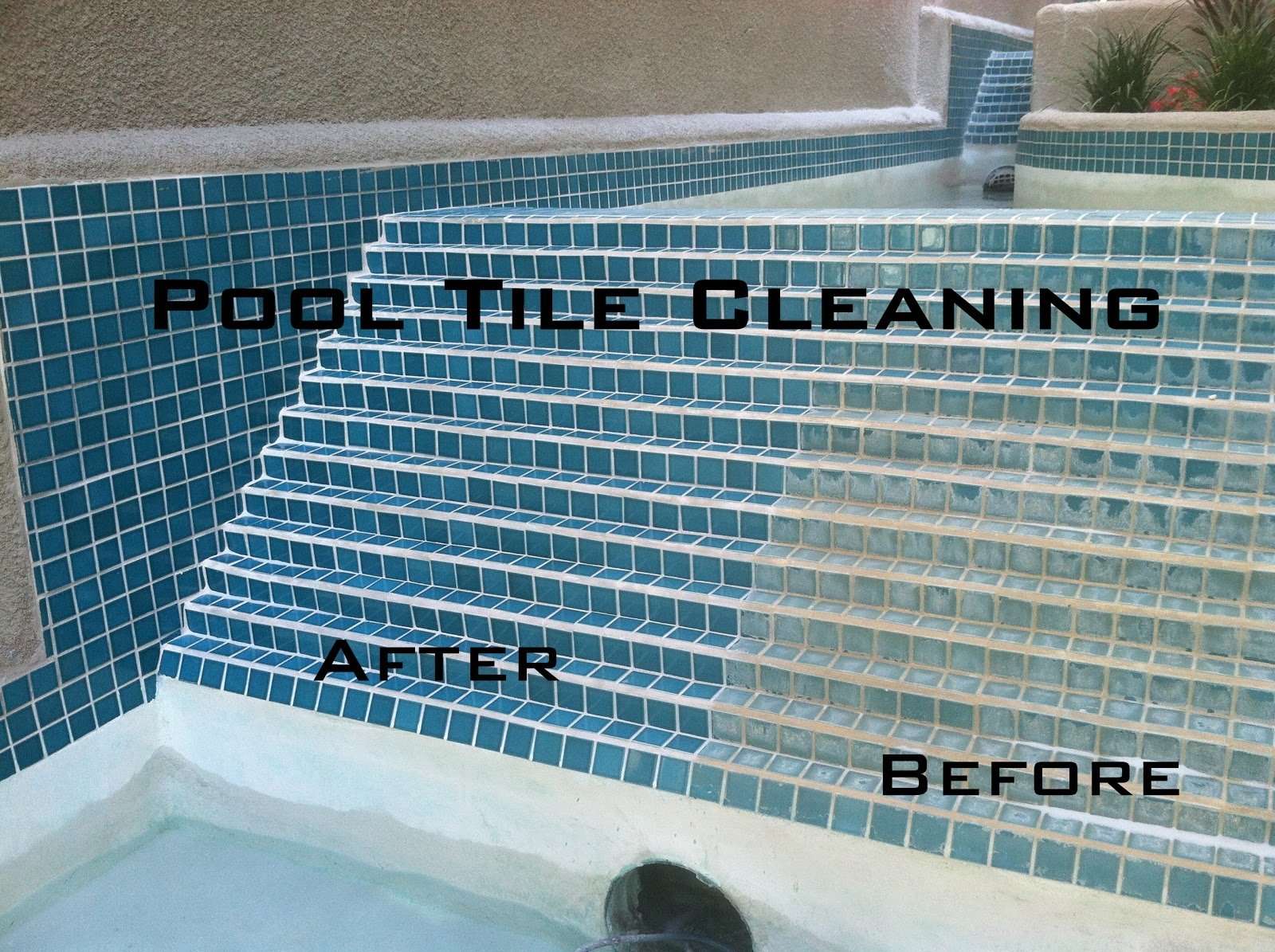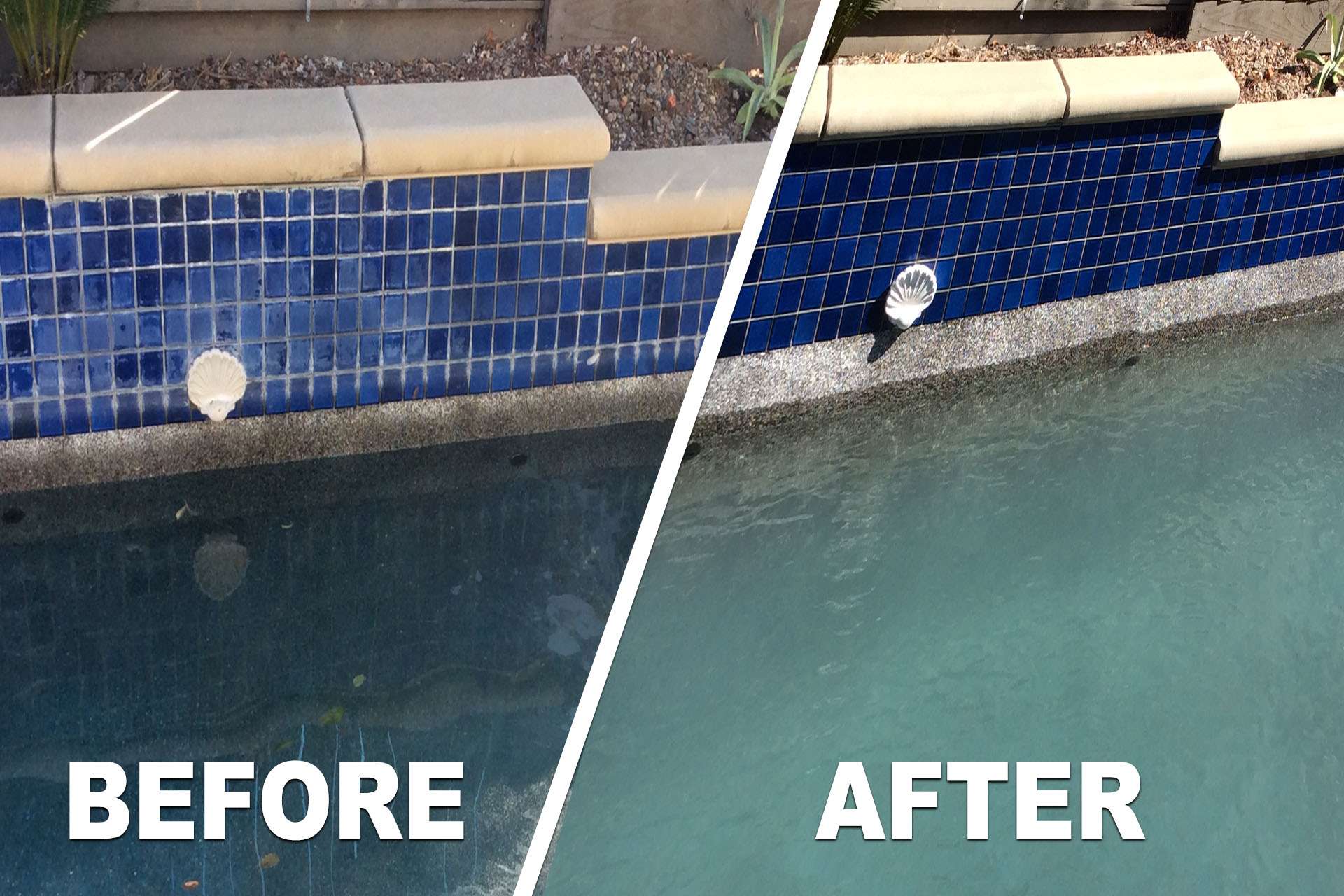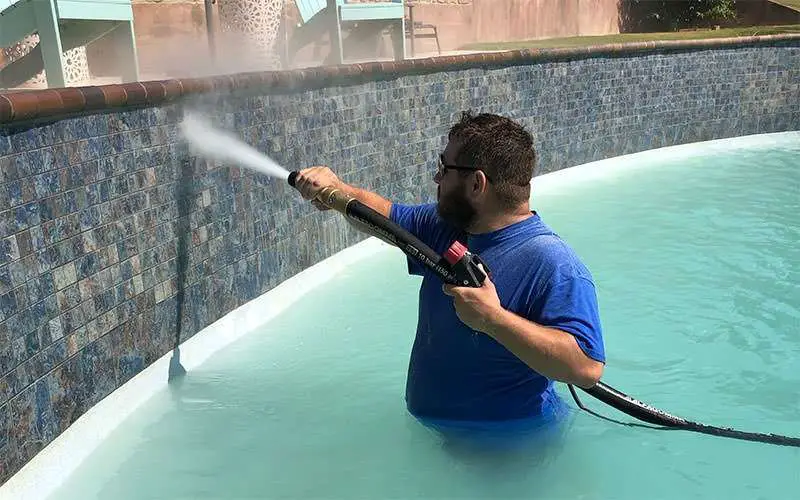Ways To Clean Pool Tile
The water in your pool contains 9 minerals, including calcium, sodium, and magnesium. As the pools water evaporates, the minerals stay behind. Over time they stick to the tiles and hide your pools beautiful finish.
If the minerals arent removed, they flake off and enter the pump system. Much like your homes water heater, pool pumps are prone to scale buildup. Too much buildup forces the pump to work harder, raising your energy bill.
Learn how to clean pool tile without draining the pool to also save money on your water bill. Change into your swimsuit and use these pool tile cleaning tips to revive your pool.
Option : Muriatic Acid
If vinegar or store-bought cleaning products dont work, the next step is to use a mixture of muriatic acid and water. You will find muriatic acid at your local pool store. Be sure to wear gloves and be careful when using the acid because it can cause burns and irritation if it comes in contact with your eyes or skin.
Clean Tile = Clean Pool
To keep your pool tile buildup-free, you should establish a good pool maintenance regimen that includes testing your waters pH and alkalinity levels and brushing your pool tile regularly.
Dont Forget the Grout!
The grout between your swimming pool tiles can be prone to algae growth. To remove algae, start by scrubbing the grout with a stiff brush. Once youve scrubbed the grout clean, rub it with a chlorine tablet. Finally, shock your pool to prevent regrowth.
Read Also: Best Pool Decking Material
Is Pool Scale A Big Deal
Yes! Calcium scale gets worse the longer you leave it. And it can cause damage to your pool and pool equipment.
To protect your family and your pool, you need to remove calcium from pool tiles. If you don’t, you will eventually be left with a host of other pool problems.
Calcium buildup can irritate the eyes and skin of your pool guests. And, it makes your pool look gross. You won’t get as many keen swimmers with a bunch of scale in the pool.
For example, pool scale can clog your pool filters. Pool filters are designed to handle bugs and leaves. But not hard calcium deposits.
When calcium runs through the filter, your pool’s system will slow down and not work efficiently.
The scale in pools also causes damage to the bottom of your pool. Over time, calcium flakes off the tiles and settles on the bottom of the pool.
This can ruin the floor of your pool and cause you to need to have it refinished. And that’s a huge expense. You don’t want that.
Here are a few ways that you can try to remove calcium from pool tiles.
How To Remove Calcium Deposits From Swimming Pool Tiles With Muriatic Acid

Muriatic acid is an acid that is hydrochloric-based and makes an excellent limescale remover. Muriatic acid washing is powerful, so we recommend wearing protective goggles and rubber gloves.
To efficiently eliminate hard water stains on tile, utilize the powerful ingredients in muriatic acid, which eat through limescale.
Combine one part muriatic acid with eight parts water in a large spray bottle. Spray the acid wash on the affected areas and let it sit for five minutes. With a nylon brush, continue scrubbing the limescale buildup until it is clean.
Finish your tile cleaning by rinsing the area with clean water. If you have to remove limescale buildup in your home, like a toilet or shower, consider using muriatic acid.
You May Like: Can Vdara Use Aria Pool
How To Clean Pool Tile With Vinegar
Vinegar can be used to remove the calcium deposition from pool tiles. You will need to have patience and wait for sometime as the effect is not quick. You will need to heat a towel or rag in the microwave or stove top before applying the vinegar to your tiles. The molecules in the vinegar react with calcium and slowly separates the deposition of calcium from tiles.
Exposure To Water & Chemicals
Though spills occur on indoor tiling, these normally get cleaned immediately. While liquid spills may cause grout on these tiles to break down, it wont damage the tile. Swimming pool tiles, however, form a bond with the tiles adhesive material, and further, they usually have water absorption rates of less than 0.5%. Swimming pool tiles must also resist erosion and pool chemicals.
You May Like: Jones Beach Fees
How To Clean Pool Tile Grout
To clean your pool tile grout, you can use a mixture of baking soda and a little bit of water to make a sort of paste. Get a cloth or sponge wet with warm water and use your paste to clean the tile. Use an old toothbrush to get in between the tiles to clean just the grout. Rinse well with a clean cloth or sponge.
Reasons To Remove Scale From Pool Tile
No one would want to swim in a pool thats dirty. Moreover, calcium scale can do some serious damage to your pool and pool equipment if its not taken care of.
If not addressed promptly, calcium deposits can result in:
- Clogged filters pool filters are designed to deal with water and pool debris such as leaves, bugs and so on, but theyre not suitable for handling hardened calcium deposits.
- Plaster damage calcium deposits can spread to other areas of the pool, potentially to the bottom where they can create pits in the plaster.
- Eye and skin irritation swimming in a pool with excess calcium deposits may irritate the eyes and skin.
Calcium deposits and scaling look unappealing, can cause serious and expensive damage, and make pools uncomfortable to swim in. There are plenty of ways to clean your swimming pool tile ranging from using vinegar and pressure washing, to cleaning with a pumice stone and using baking soda. Heres the process involved in cleaning pool tile with baking soda:
Recommended Reading: Dolphin M600 Amazon
What Is The Best Way To Clean Pool Tiles
The best way to clean your pool tiles is by using a pressure washer. That is because it is the fastest, cheapest, and most effective. All you need is your washer and a source of water. Most of the time, you do not even have to use a cleaning agent.
Pressure washers also remove all kinds of dirt from your pool, including calcium buildups, algae, moss, grime, mud, and even chewing gum.
How To Clean Pool Tile With A Pumice Stone
A pumice stick works well to scrub off that last bit of calcium that a scraper just cant get under. While its generally safe to use pumice on tile, always test on a low key area of your tile first. You can usually find pumice sticks at pool stores, home improvement stores, and even online.
One other way to clean your pool, but is a little more in depth, is Acid Washing.
Read Also: Pool Balance Calculator
How To Use A Pressure Washer To Clean Pool Tiles
Where and how to get a pressure washer is not the problem. The real problem is how to use it to properly wash your pool tiles. Pool tiles are made from either ceramic or porcelain, which makes them vulnerable to damage when using a pressure washer.
Pressure washers release water at very high pressures, which is why you have to be careful when using them to wash your pool tiles. The following guide provides some tips that you can follow to ensure that you clean your tiles properly without damaging or breaking any of them.
One of the reasons why pressure washers are a good option to eliminate all the stubborn stains and moss on the pool tiles is the pressure they deliver the water with. When washing your pool tiles, you have to ensure that pressure is not too high or too low.
A powerful pressure washer may chip off the grout, making your tiles vulnerable to falling off and breaking. Little pressure, on the other hand, is not enough to remove the dirt off the tiles. The right amount of water pressure for your pool tiles is around 2,000 PSI.
You also have to understand how strong your pool tiles are. To ensure that the pressure is enough, you should first test it on a spot that is not easily visible. If you notice that the pressure damages the tiles or does not clean them properly, adjust it to the desired level.
All of them are color-coded to help you choose the right one
Why Do Pool Tiles Get Dirty

It may seem a usual event for pool tiles to build up a layer of white scum on the side, just above the water level. Natural evaporation reduces the waterline and leaves it vulnerable to staining. Having high pH levels or high alkalinity as H2o evaporates causes Calcium to adhere along the path of the water’s edge, slowly going down. The ideal numbers are pH of 7.4 and alkalinity ranging between 80 and 120 PPM .
Also, an inadequate chemical imbalance of pool-water chemicals causes scales and stains to appear at the water’s edge. Thats why basic know-how of what and why pool water needs, so you stay away from problems.
On general occasion, it is scale or stain that cause discolouration, but so do falling leaves that stick to the sides.
Is all calcium build up the same? No.
You have two primary culprits:
Mind both and scrub tiles in time.
Don’t Miss: How To Hide Pool Equipment
Hire A Professional Bead Blaster
If removing the pool scale doesn’t work with the methods we’ve already listed, you probably have a severe case of pool scaling that needs professional attention.
You can hire a professional pool company to come to your pool to remove the calcium. This process is called bead blasting and is sometimes called pressure washing.
This service is different than how you would use a pressure washer to wash your car. Professional companies use a compressor to blast sand, beads or other materials at the pool tile at high speed.
This scrapes away the buildup quickly. And you don’t have to spend time scrubbing the tile yourself.
Most companies use magnesium sulfate to blast the calcium off your pool tiles.
Note, this option can be very expensive. Ideally, you want to remove calcium buildup on your own. And practice good pool maintenance to prevent pool scaling in the future.
Types Of Pool Cleaning Brushes For Tile
You should choose a pool cleaning brush designed for your type of swimming pool. For instance, if the tile is in a plaster pool, you can use a pumice stone or a hard bristled brush. However, for a fiberglass pool, accidentally brushing the liner with a hard brush can cause damage. For this reason, it is best to use a textured, soft sponge on your water line tile in fiberglass pools.
Read Also: How Do You Build An Inground Swimming Pool
Cleaning Pool Tile Without Draining
To clean a pool without draining it requires going through the process of acid washing the pool. This process is quite different from the acid washing process discussed earlier.
YOULL NEED
Test kit/Buffer to measure alkalinitypH increaser
STEPS
1- Start filtering the pool a week before the cleaning process to keep the water clean and clear. You can achieve this by continuously pumping water for a few days before the cleaning process begins.
2- Clear out the unimportant and unneeded objects from the pool area.
3- Thoroughly clean the pool with a vacuum cleaner or scrub it with a brush.
4- Add 16 oz of any acid washer per 10,000 gallons and about 8lbs of pH decreaser per 5,000 gallons until the waters alkalinity is at zero. You can use a test kit or a buffer to measure this.
5- Brush the stains from the tiles. Repeat this process for two to three days.
6- When it is clear that the tiles are clean, restore the alkalinity of the water.
7- To do this, add 8lbs of pH increaser per 5,000 gallons on three separate occasions with a 6-8 hour time difference.
8- Repeat the process until the pH and alkalinity of the pool are at the required level.
Pressure Washing Pool Tiles
If you are a DIY’er when it comes to in-ground pool maintenance, renting a pressure washer may be a good option for you. This is the best way to clean a pool tile that is safe and chemical-free.
You need no detergents for pressure washing. Pressurised steam set at 2000 to 2600 PSI can remove built-up dirt, mould, and calcium deposits.
Recommended Reading: Mandalay Bay Pool Hours Winter
How To Clean Pool Tile And Remove Calcium
Many in-ground pools feature beautiful, multi-colored ceramic or glass tiles that look great if kept clean and well-maintained. But if the tiles arent maintained, they can become stained or covered in buildup. Fortunately, you can take some quick, easy steps to clean the tile and bring it back to its original luster.
But before we talk about how to clean that tile, lets get some basics out of the way.
What Exactly Are These Stains And What Can You Do To Remove Them
Most likely, stains along the waterline are calcium deposits. Unfortunately, these deposits can be difficult to clean. There are several reasons you may start noticing calcium deposits on the tiles along your waterline.
- Hard water can leave behind calcium residue over time. If you live in an area with hard water, youve probably already noticed calcium buildup on sinks and faucets.
- The second culprit is heat, which not only causes water to evaporate more, but also raises the temperature of the water.
- If your pool has high alkalinity, high pH and warmer water due to high temperatures, you can expect calcium scale to begin forming.
You May Like: How Do You Get Iron Out Of Pool Water
Pool Tile Cleaner Tips
Hopefully you have worked through the above steps and are left with sparkling clean tile but if you are still unable to removed the stains and buildup there are a few options that you might want to consider. The absolute best way to deal with stains is to prevent them but if it’s too late you may need to hire a professional pool cleaner or a company that specializes in pool tile cleaning.
Bead Blasting
If your build up is so stubborn that you can’t remove it with a pumice stone and cleaner or you want to hire a local pool company to do the dirty work you should consider bead blasting. This technique uses high pressure air similar to sand blasting that will break away calcium, lime or hard water stains that can’t be removed with a pumice stone.
Pool Chemistry
The best way to never have to deal with stained tile is to keep you pool properly balanced with special attention to calcium hardness, pH and alkalinity. There are products on the market that will help ensure your pool remains stain free and are specially formulated with this exact purpose in mind. If you are cleaning stains caused by pool algae it would be ideal to read about ways to prevent a bloom in the first place.
We hope this guide about pool tile cleaner was helpful and hopefully you were able to get your tile looking as good as new. If you suspect your pool chemistry was to blame for the stains be sure to monitor your chemicals so you can prevent future problems.
Using A Pressure Washer To Clean Pool Tile

The use of a pressure washer in cleaning pool tiles has increased over the past few years because it is efficient and quick. As a rule of thumb, ensure you use the correct medium in blasting away the calcium deposition. Its worth remembering that there are varieties of mediums for different types of tile, and you must understand the exact tile in your pool to get the best results. This will ensure that the medium you use doesnt harm your tile. After all, its better to be safe than sorry.
You May Like: How To Deter Wasps From Pool
Cleaning Pool Tiles Calcium Deposits With A Pressure Washer
A great addition to your pool service routine is a pressure washer, which uses intense force to spray water at a fast rate, breaking through calcium hardness that is often difficult to remove.
An alternative to pressure washing is bead blasting, which applies glass beads at high pressure and does not cause damage.
If you do not have a pressure washer in your garage, do not worry. Pressure washers are commonly found at your local home improvement store to rent.
Aim the nozzle at areas with calcium deposits and just above the water level to clear away deposits. Do not wash any tiles that are loose or cracked, as pressure washing may cause more damage.
Learning how to remove calcium deposits from swimming pool tiles is easier with a pressure washer.
Pool Tile Calcium Removal
There are several ways you can remove calcium scaling with the method described below. You need a pumice stone or hard-bristled brush, and a calcium releaser. Follow the steps below:
Only use pumice stone on hard surfaces such as concrete, plaster and tile and not on softer surfaces such as fiberglass and vinyl pools. For softer surfaces, use a nylon brush.
For calcium deposit releasers, use the ones that are biodegradable, free of acts and non-toxic. Otherwise, youll be forced to drain the whole pool after cleaning.
Recommended Reading: Open Pools In San Antonio
